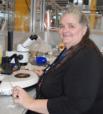Minerals
ANSTO's Minerals team provides consultancy, process development and research services to the mining and minerals processing industries.

Showing 441 - 460 of 1181 results
ANSTO's Minerals team provides consultancy, process development and research services to the mining and minerals processing industries.
Synchrotron infrared technique reveals first insights into evolution and structure of Australian basket-web spider’s silk.

Let your students lead a 30-minute Q&A session with our ANSTO experts about one of the following three topics:
- Nuclear medicines
- Nuclear techniques to study the environment
- Fission and its applications in reactors
Please ensure your students do some pre-reading about the research topic and come prepared with questions to ask during the session. We also ask that teachers send us a copy of the student questions the day before, so we can adequately prepare for your session. Teachers must be present during the session with their students.
Cost: Free

ANSTO works in partnerships and collaborative ventures with national and international organisations. Partner with ANSTO.
ANSTO is participating in a new Australian Research Council (ARC) Centre of Excellence for Indigenous and Environmental Histories and Futures (CIEHF) to be headquartered at James Cook University (JCU) that aims to bring Indigenous and environmental histories to the forefront of land and sea management.
Cosmogenic nuclides measurements at ANSTO to be part of large international Antarctic glacier research.
ANSTO is one of the world's leading providers of irradiation services for silicon ingots, which are used by the multimillion dollar electronics industry across Europe and Asia. Each year, ANSTO irradiates more than 50 tonnes of silicon.
Atomic mechanism produces colossal cooling effect in new class of materials .
Research has helped build a record of rainfall during the late Pleistocene and Holocene, and shed light on the strategies of Indigenous Australians to cope with a changing landscape.
Funding awarded for research on an additive manufacturing technique for use on rail infrastructure.
Sample environment types that are available on the Powder Diffraction beamline.
Low-cost X-ray detectors featuring high sensitivity, durability and physical flexibility are required in fields ranging from medical imaging to defence. In this study, a new material for X-ray detection was coupled with inkjet printing to produce a series of prototype X-ray detectors.

Research undertaken by Flinders University, the University of Cincinnati (US), Guangzhou University (China) and ANSTO has evaluated a new process to encapsulate fish oil in nanoparticles
Part of the Large Hardon Collider
New three year study with UNSW for Cotton Research Development Corporation.
Study shows for the first time that vegetation in the Windmill Islands, East Antarctica is changing rapidly in response to a drying climate.